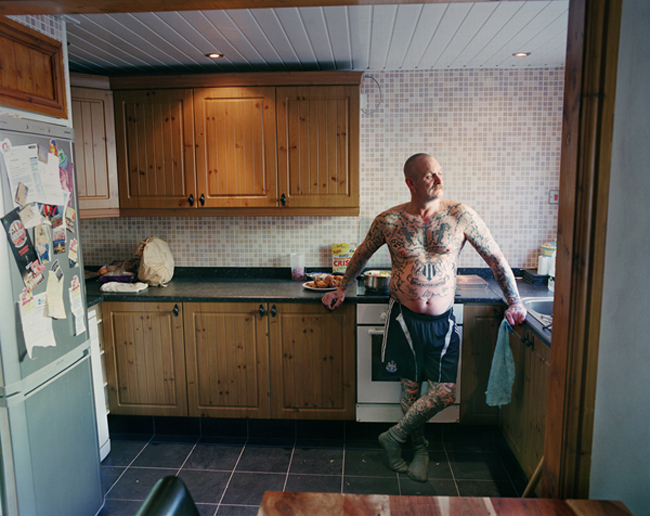THE OUTSIDER’S VISION
November 30th, 2009 adminAs Peter Hamilton identified in his recent article in the BJP, some of the most acute observations of Englishness have been made by foreign photographers. Hamilton writes- “An outsider can stand back from the society and look at it dispassionately, finding equally odd and worthy of note the things the locals take for granted. This was probably why the German-born Brandt found the juxtapositions of his The English at Home so much grist to his mill.”
Alongside the photography of Brandt, Hamilton cites another body of work – Charmes de Londres (1952) – a collaboration between Izis-Bidermanas and Jacques Prevert, which uses place in the sense of the great metropolis as a signifier of Englishness. Though intended for a French market, it was also published in English as Gala Day London in 1953, with an additional text by John Betjeman, a quintessential expert on Englishness. As Hamilton explains “Izis deals in many ways with cliches about the English. There are foggy streets, Tower Bridge glimpsed through a grimy warehouse window, Thames-side activity, Battersea power station, street markets and the East End. But it is also a view that humanises the streets and offers a visual perspective that was influential for the Picture Post generation.”
A more contemporary study made by a foreign photographer would be Byker Revisted by the Finnish photographer Sirkka-Liisa Konttinen. She is perhaps best known for her book Byker (1983), a seminal portrait of the terraced Newcastle community, eventually bulldozed to make way for the Byker Wall and the wholesale redevelopment of the area. She began her project in 1969, when she moved to the North East of England and lived in Byker for seven years, until her own house was demolished. Thereafter she continued to photograph and to collect testimonies from the residents for a further five years. Sirkka returned in 2003, negotiating an individual journey through the new Byker, building a portrait of the estate as it stands today. Here are some of the new photographs-
 David with daughters Kadie and Robyn and Ty-dog © Sirkka-Liisa Konttinen, 2008
David with daughters Kadie and Robyn and Ty-dog © Sirkka-Liisa Konttinen, 2008
 Colin © Sirkka-Liisa Konttinen, 2009
Colin © Sirkka-Liisa Konttinen, 2009
Some individuals had been photographed in the original project. In an official explanation of the work, we’re told that Sirkka “found a few of the remaining extended families of the traditional working class for whom the estate was designed. There are the self-defined individuals who seem to flourish in a street plan outsiders find impossible to navigate. Perhaps because she had been a stranger in the original Byker, Sirkka found herself drawn to the refugees, housed in the hard-to-let properties at the bottom of the estate, where the limitations of its planned lifespan have become most visible.”
 Asylum seeker family from the Middle East © Sirkka-Liisa Konttinen, 2007
Asylum seeker family from the Middle East © Sirkka-Liisa Konttinen, 2007
 Jean with daughter Gemma and her friend Kara © Sirkka-Liisa Konttinen, 2007
Jean with daughter Gemma and her friend Kara © Sirkka-Liisa Konttinen, 2007
You can see more of the photographers here.
Born in Myllykoski, Finland, in 1948, Sirkka began taking photographs at the age of twelve, inspired by her aunt Oili, who was a skilful amateur photographer. She developed a keen interest in documentary photography and later decided to study film making in the UK, enrolling at the Regent Street Polytechnic film school in London. Whilst there, she met up with Murray Martin and a number of other fellow students, with whom she formed the Amber Collective. In 1969, the collective moved to Newcastle upon Tyne in the North East of England, with a commitment to documenting working class communities, in film and in photographs.
Here are some of her original Byker photographs (more of which you can see online here):
 Kendal Street © Sirkka-Liisa Konttinen, 1969
Kendal Street © Sirkka-Liisa Konttinen, 1969

Children playing house with discarded junk near Byker Bridge © Sirkka-Liisa Konttinen, 1971

William (Willie) Neilson, Lawrence Square © Sirkka-Liisa Konttinen, 1971

Young woman in Mason Street © Sirkka-Liisa Konttinen, 1971

Isaac in front of his ‘Raby Swap Shop’ © Sirkka-Liisa Konttinen, 1974
Another foreign photographer whose work you can find on Amber Collective is that of Peter Bialobrzeski. Bialobrzeski spent a year documenting Britain between 1991-1992 for a project called ‘Give My Regards to Elizabeth’. The work was shown at Side Gallery in 1993, however, it was never published as a book. You can see a selection of images on the Amber website here.
Over the years Amber has built up a significant photographic collection, much of which you can now view online. And it’s well worth a look (here).

